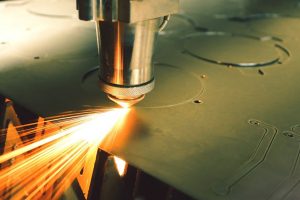The Great Debate: Laser Die-Cutting vs. Rotary Die-Cutting

Cutting is an integral part of any manufacturing process. A high-speed, accurate, and versatile cutting apparatus allows you to divide a bulk of products into its individual units. This industrial-grade cutting equipment is also needed when you print product labels. If you need to cut the entire roll of custom labels with precision and fast turnaround a laser die cutter may make sense.Today, laser die-cutting and rotary die-cutting are the two most prevalent industrial cutting methods. Which one is more suitable for your label printing setup? Let’s find out in this showdown of die-cut vs. laser-cut machines.
Turnaround Time
Suppose you want to streamline your supply chain and ensure that a product dispatch is not delayed due to its packaging and labeling. In that case, you need cutting equipment that can keep on producing different sets of label cuts without needing any feedback or part replacement.A laser die cutting machine is ideal for this purpose. For the rotary finishing, you will need a separate die for every different type of cut. This can be costly and time consuming to keep changing these dies out for each design. Laser on the other hand can cut any size, any shape, without any change over of parts.Laser finishing is especially beneficial when it is paired with digital label printing. This allows you to cut any label design without having to buy a special die for it. Digital printing technology paired with laser die cutting is especially beneficial for short and medium print jobs.
Verdict: Laser cut offers a quicker turnaround than analog solutions, especially for custom shapes and short run label production.
Attention to Details
Rotary die cutters can cut plain, linear patterns at high speeds. If your labels or packaging entails intricate designs, such as cut outs or starburst patterns, you will need the precision and delicacy offered from laser die cutters. No matter how unique and challenging your label’s shape is, a top-quality laser label finisher can cut it while maintaining every little detail.
Verdict: Laser die-cutting is more advanced than rotary die-cutting when it comes to cutting complex shapes with desired precision and finishing.
Bulk Label Cutting
If you need to cut the same pattern across a bulk of printed sheets, a rotary die cutter comes out as a better alternative. It can make more cuts in lesser time, especially if the sheet is thicker than usual. Typically, longer print runs should be finished on an analog finishing solutions such as the
MEBR+.
Verdict: Laser die-cutters are not as efficient as rotary or semi-rotary die cutters for large runs.
Maintenance
Rotary die cutters are like any other mechanical equipment. Its metal-cutting dies get blunt with use. Refurbishing or replacing them doesn’t just mean continuous maintenance but potential downtime as well. You don’t face this problem while using laser die-cutting.
Verdict: Laser die-cutter fares better than rotary die cutter when it comes to maintenance requirements.
Upfront Cost
Laser die-cutting is considered a piece of modern technology. Therefore, setting up a laser die cutting setup involves a higher upfront cost than establishing rotary die-cutting. There are some options out there that are very affordable, such as the
Anycut I and
Anycut II laser finishing systems from Anytron.
Verdict: Installing a rotary die cutter is cheaper than buying a top-quality laser diet cutter.
Final Verdict
From the above analog vs. laser cutter showdown, you can figure out that the laser die-cutting equipment is suitable for any manufacturers that have started printing their custom labels and don’t require too much cutting power. In contrast, rotary die cutters are ideal for all those printing simple non-custom labels in bulk for other ventures.If you need a high-quality laser die label finisher for your custom labeling set up, check out the distributor network of
Arrows System Inc. Rest assured that you won’t be disappointed.
 Cutting is an integral part of any manufacturing process. A high-speed, accurate, and versatile cutting apparatus allows you to divide a bulk of products into its individual units. This industrial-grade cutting equipment is also needed when you print product labels. If you need to cut the entire roll of custom labels with precision and fast turnaround a laser die cutter may make sense.Today, laser die-cutting and rotary die-cutting are the two most prevalent industrial cutting methods. Which one is more suitable for your label printing setup? Let’s find out in this showdown of die-cut vs. laser-cut machines.
Cutting is an integral part of any manufacturing process. A high-speed, accurate, and versatile cutting apparatus allows you to divide a bulk of products into its individual units. This industrial-grade cutting equipment is also needed when you print product labels. If you need to cut the entire roll of custom labels with precision and fast turnaround a laser die cutter may make sense.Today, laser die-cutting and rotary die-cutting are the two most prevalent industrial cutting methods. Which one is more suitable for your label printing setup? Let’s find out in this showdown of die-cut vs. laser-cut machines.